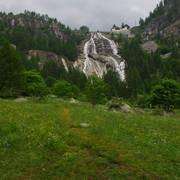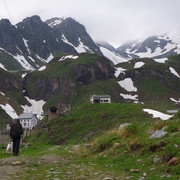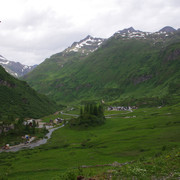A tarmac road leads from Riale to the Toce waterfalls, from where a steep trail connects with the road to Canza. From here the trail plunges into a wood and heads towards the Lake Vannino dam. The trail passes the Myriam hut on the left and reaches the Vannino-Margaroli hut at the dam itself.
Easier alternative route
There is a dirt track that leads from Canza to the top of the chair lift. The trail begins again from there.
| Point |
Segment |
|
Name |
Services |
|
Information |
Marking |
 |
Riale
1733 m
|
|
|
|
|
|
|
A
4.4 km / 1h00 |
 |
 |
Canza
1421 m
|
|
|
|
|
|
|
B
4.7 km / 2h00 |
 |
 |
Rifugio Myriam
2000 m
|
|
|
|
|
|
|
B
2.5 km / 0h45 |
 |
 |
Alpe Vannino
2185 m
|
 |
Detailed route description

From the village of Riale follow the road to the Toce waterfalls from where a steep trail leads down to the main road to Canza. From the village the trail climbs through a wood. (There is an alternative, which is to follow a track to the top of a chairlift). The trail passes the Myriam hut on the left. Finally, at the top, is the Margaroli hut, near the Lake Vannino dam. The following climbs are possible from the Margaroli hut: Mt.Giove; the Satta peak; the Curzalma peak; the Forno peak; the Vannino peak; the d'Arbola peak; the Corni di Nefelgiù peak.
(Regione Piemonte)
Natural and cultural heritage

La Frua (Uf-a-Frutt) 4530m: the "big jump" of the (Frua) del Toce waterfall (143m). During the week the water is channelled elsewhere but at the weekend and in summer the waterfall becomes quite a spectacle as the water topples over the white cliff. It is said to be the most beautiful waterfall in Europe. Riale: the town lies in a shallow valley. A church juts out on an outcrop, built in memory of the Oratory that is now under the waters of the artificial lake at Morasco. Canza: the last inhabited hamlet of Formazza is known in dialect as "Frudu wald" (waterfall woods). It is cut in half by the Toce stream. In 1951 it was partly destroyed by an avalanche but the houses were all rebuilt in traditional style - wood and stone. This valley is the oldest settlement of the Walser people south of the Alps. Peasants and shepherds came here in the 13th century from the Valais. Of Germanic stock, they came from Switzerland and were mostly peasants and merchants. Walser culture can be seen in the architecture of the houses and the churches, but also in their culinary traditions, with dishes such as Bettelmatt cheese, Montecrastese bacon, Walser bresaola and cuchéla.
(Regione Piemonte)
Other long-distance trails and alternative routes
Sentiero Walser, which follows old trails of the 14th century used by the first Walser settlers via the Albrun pass from Binn valley, then Scatta Minoia, Lake Vannino and Canza. Alta Via delle Alpi Ossolane, which crosses the Val Strona, Macugnaga, Antrona, Bognanco, Alpe Veglia e Devero to reach the Val Formazza; since 1995 it is part of the GTA trail.
Useful topographic maps
-
11 Domodossola e Val Formazza ~ IGC (1:50000)
-
29 Domodossola ~ Kompass (1:50000)
Useful guidebooks
-
Val Formazza, 36 escursioni scelte- Crosa Lenz P., Frangioni G. ~ (ISBN Domodossola 2002)
-
Ambiente e sistema edilizio negli insediamenti walser di Alagna, Macugnaga e Val Formazza - Mirci Cappa M. ~ quaderni di cultura alpina-Priuli&Verlucca (ISBN Domodossola 2002)
Websites relative to natural and cultural heritage
Last update : 2013-07-15

 |
3h45 |
11.6 km
|
966 m
|
514 m
|
3h45 |
11.6 km
|
966 m
|
514 m























Favourites, criticisms ? Make your personal comments on this stage. For more general notes please use the comments section of the page Over to the Via Alpinists.